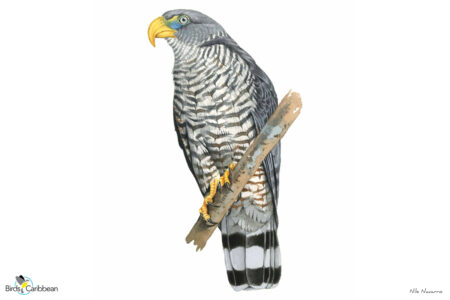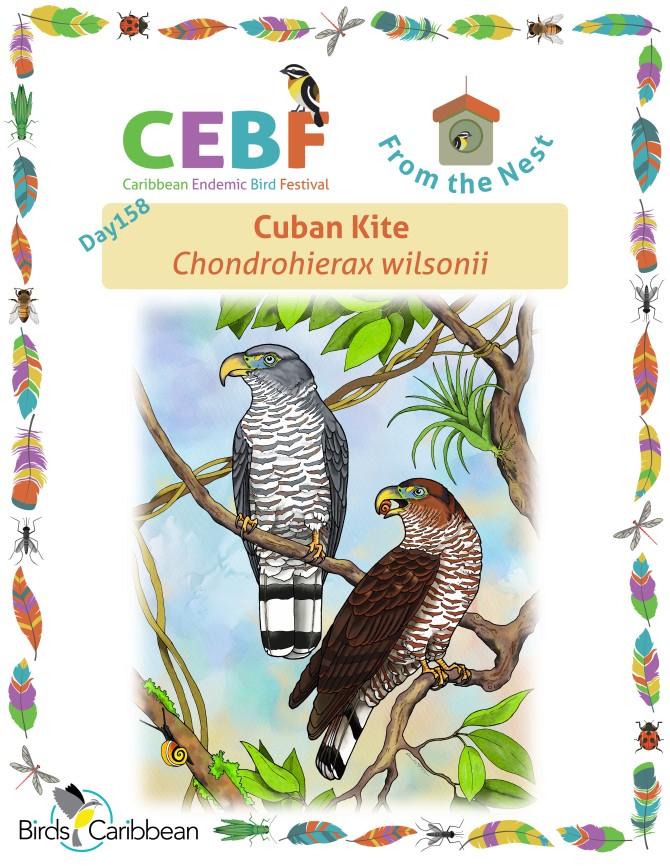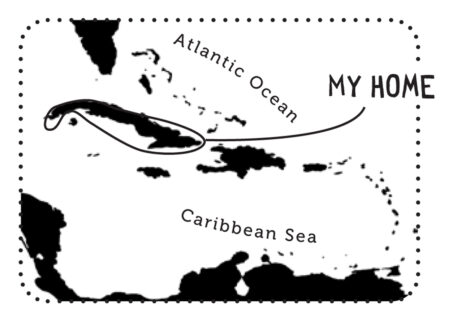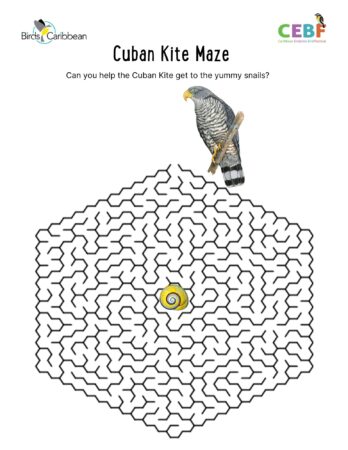Celebrate the Caribbean Endemic Bird Festival (CEBF) with us! Our theme in 2024 is “Protect Insects, Protect Birds”—highlighting the importance of protecting insects for birds and our environment. Have fun learning about a new endemic bird every day. We have colouring pages, puzzles, activities, and more. Download for free and enjoy learning about and celebrating nature!
Endemic Bird of the Day: Cuban Kite
Today we delve into the natural history of a fascinating, elusive, and controversial bird—the Cuban Kite (Chondrohierax wilsonii)! It is a distant and mysterious relative of the widely known Hook-billed Kite (Chondrohierax uncinatus). The Cuban Kite is an endemic species confined to the beautiful island of Cuba where it is called Gavilán Caguarero.
Although once sighted in various regions, from the lush savannas of Cienfuegos to the wetlands of the Zapata Swamp, its presence nowadays is restricted to the far eastern part of Cuba, specifically in the provinces of Holguín and Guantánamo. Unfortunately, its appearance in these territories has become so rare that there are serious concerns about its possible extinction, or at least its imminent functional disappearance.
The taxonomic history of the Cuban Kite has been as intriguing as its existence in the wild. Named by the prominent ornithologist John Cassin in the 19th century, this bird has gone through periods of uncertainty regarding its taxonomic status, oscillating between being considered an independent species and then as a subspecies of the Hook-billed Kite. However, it has recently regained its status as a separate species, a well-deserved recognition for this marvelous raptor.
One of the most distinctive features of the Cuban Kite is its plumage and massive bill, which reveal its unique identity. With its broad wings and barred tail, and a notably large and hooked yellow bill, this elegant raptor stood out in the Cuban landscape. It was once incorrectly believed that the Cuban Kite feasted on birds, especially doves, and the occasional lizard. But this Cuban emblem has a more sophisticated palate and prefers escargot. This bird feeds exclusively on tree snails! In the eastern part of Cuba its primary food source is the Cuban painted snail (Polymicta picta), however this species does not occur in its former range in west-central Cuba, where tree snails of the genus Liguus (presumably L. fasciatus and L. vittatus, based on range) might be its alternative food source. The Cuban Kite uses its strong hooked bill to pierce or crush the mollusk’s shell before slurping up the soft snail. As a famous animated lion cub once said, “Slimy…yet satisfying!”
Currently there are no sound recordings for the Cuban Kite, but in flight calls are believed to be very similar to that of the Hook-billed Kite. Additionally, with just a handful of sightings, most recently in 2010, information on its breeding ecology, and other social or antagonistic behaviours remain unknown.
However, ornithologists are certain that the survival of the Cuban Kite is in jeopardy. Habitat destruction, indiscriminate snail collection, and direct persecution by farmers who mistakenly believe it preys on their poultry represent significant threats to its existence. The shells of the snails that the kite feeds on come in a wide variety of colors: pastel yellow and pink, brick red and black, pearly white and ochre and are sought by collectors who sell them to tourists or trade them to the US and Europe.
The Cuban Kite reminds us of the fragility of wildlife and the importance of our role as stewards of nature. It is crucial to organize expeditions to search for the Cuban Kite and implement urgent conservation measures, ranging from the protection of its vital habitat to public awareness of the importance of preserving this unique and little-known species. Every effort to protect this majestic bird contributes to maintaining Cuba’s rich biodiversity and preserving an invaluable treasure for future generations. Learn more about this species, including its range, photos, and calls here. Great news! If you’re in the Caribbean, thanks to BirdsCaribbean, you have free access to Birds of the World and you can find out even more in the full species account of this bird!
Thanks to Arnaldo Toledo for the illustration and Nils Navarro for the text!
Colour in the Cuban Kite
Download our West Indies Endemic Bird colouring page. Use the photos below as your guide, or you can look up pictures of the bird online or in a bird field guide if you have one. Share your coloured-in page with us by posting it online and tagging us @BirdsCaribbean #CEBFfromthenest
Puzzle of the Day
Click on the image below to do the puzzle. You can make the puzzle as easy or as hard as you like – for example, 6, 8, or 12 pieces for young children, all the way up to 1,024 pieces for those that are up for a challenge!

Activity of the Day
FOR KIDS : The only food the Cuban Kite will eat is tree snails! They use their huge strong hooked bills to pierce or crush the snail’s shell, before slurping up its soft insides.
Can you help this hungry Cuban Kite find its way through our maze to to grab some tasty snails?
You can find the correct route here.



